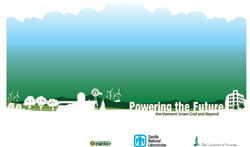
Sandia and University of Vermont sponsored “Powering the Future: The Vermont Smart Grid and Beyond.”
A few years ago, Vermont Sen. Bernie Sanders attended a field hearing on concentrating solar power at Sandia National Laboratories in New Mexico. The hearing sparked an idea that has blossomed into a nearly unprecedented collaboration to tackle a complex and important challenge to the country’s energy future: modernization of the electric power grid.
This week a conference, “Powering the Future: The Vermont Smart Grid and Beyond,” brought together a diverse group of 150 researchers and scientists, educators, industry partners, state legislators and regulators. Sandia National Laboratories and the University of Vermont (UVM) sponsored the conference to provide a forum to discuss Vermont’s deployment of smart meters to 85 percent of the state, and how to build on this to create a statewide “smart grid.”
Smart meters are an initial and important component of a smarter grid, conference participants said. They can provide enhanced information to customers and to power companies such as real-time or near real-time sensors, notification systems, and power quality monitoring. Smart meters make it possible to better use distributed energy technologies and offer more active consumer participation.
Vermont received a $69.3 million e-Energy American Recovery & Reinvestment Act (ARRA) grant to fund the smart meter implementation program. Vermont’s utility companies are matching the grant, for a total of $139 million.
The U.S. electric power infrastructure is rapidly running up against its limitations, according to the Department of Energy. The systemic risks associated with relying on a frequently overtaxed grid grow in size, scale and complexity every day.
Creating a smarter, more responsive electric power grid is not just a technical challenge; it’s also a cultural, policy and logistics challenge.
“Forging close partnerships between government, industry, and education will allow our nation to tackle this complex problem and prepare us to tackle future challenges,” said John Evans, senior adviser to the University of Vermont president.
“Vermont was a natural choice for this project,” said Rick Stulen, vice president of Sandia’s California lab (8000) and leader of the Energy Climate and Infrastructure Strategic Management Unit. “The state is further along in regulatory reform, and its utilities have all collaborated to further the advance of smart metering in the state. The unique consumer culture in Vermont also made this a good fit; Vermont consumer culture is attuned to energy issues, and is interested in participating actively in efficiency activities.”
And it’s not just Vermont power consumers who believe in mindful stewardship of the nation’s energy.
“My passion is in creating a smarter, cleaner, greener, more effective energy future for Vermont,” said Mary Powell, President and CEO of Vermont-based Green Mountain Power. Green Mountain Power is one of the Vermont utilities that collaborated on the ARRA Smart Grid grant that brought smart metering to Vermont.
To enhance collaborations further, Sandia Labs received a nearly $1 million DOE Electric Power Fellowship Grant to fund internships for nine Vermont students to travel to Sandia in New Mexico this summer to work on electric power-related projects. The grant also supports the visits of eight UVM professors who will come to Sandia to collaborate on projects related to smart grid implementation.
“The Vermont-Sandia partnership, when fully realized, will conduct advanced research that will bring us closer to energy self-sufficiency in this nation that will greatly increase energy efficiency, and that will help develop a new green economy,” said Sen. Sanders. “This partnership will work with businesses and academia to develop new technologies, new policies, and new procedures to move our nation forward in the 21st century and create good-paying jobs in the process.”
Grid modernization requires a new generation of field engineers, control-room operators and others that understand not only the technical complexities of intelligent communications systems, dynamic load management and renewables integration but also the larger policy and economic implications of these systems.
Sandia researchers have also held technical talks at UVM on such topics as smart grid, solar energy, climate change technology and cybersecurity. And the exchanges will be ongoing. More energy-related UVM short courses will take place at the end of the summer on cybersecurity, grid integration of renewables and global smart grids.
All of the conference participants expressed hope that this partnership will lead to innovations that prepare the nation to successfully modernize and enhance the capability of the American electrical grid.
Sandia National Laboratories is a multiprogram laboratory operated and managed by Sandia Corporation, a wholly owned subsidiary of Lockheed Martin Corporation, for the U.S. Department of Energy’s National Nuclear Security Administration. With main facilities in Albuquerque, N.M., and Livermore, Calif., Sandia has major R&D responsibilities in national security, energy and environmental technologies, and economic competitiveness.
Sandia media relations contact: Stephanie Holinka, slholin@sandia.gov (505) 284-9227